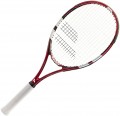Frame material
The material from which the racket frame is made. Today, the most popular are two solutions: aluminium alloy and carbon (graphite).
Aluminium alloy is the simplest, most affordable and reliable solution, which nevertheless is not very popular in modern sports. The advantage of aluminium rackets is their long service life and good resistance to mechanical damage — it is quite difficult to break them on the court. Most often used in the production of children's rackets.
Carbon (graphite) is the most popular material today for making tennis rackets, both professional and amateur. It boasts low weight and good strength. It is quite rare that rackets are made from pure carbon; more often, various metal alloys are used (carbon, titanium, etc.), and each manufacturer has its own “recipe” for the ideal alloy.
Handle size
It is customary to read that the thickness of a tennis racquet should be such that when it is grasped between the fingers and the palm there is a gap slightly larger than the thickness of the index finger. There are two generally accepted systems for measuring handle thickness: American and European. If within the first one, the indicator is measured in inches, then within the European one — in integers from 0 to 5, where zero is the smallest size. Usually, each racquet is presented on the market with modifications with a different handle diameter. So, the indicator "1-5" means that the model is represented by modifications with a handle diameter of 1, 2, 3, 4, 5. Exceptions may be some children's rackets, for which the manufacturer sometimes does not indicate the diameter of the handle, since it is less than size 0.

